Lambert Sustris stands as a fascinating figure in the complex tapestry of sixteenth-century European art. Active during a period of immense artistic innovation and exchange, he was a painter of Northern European origin, likely Dutch, who carved out a significant career primarily in Italy, most notably in the vibrant artistic crucible of Venice. His life and work exemplify the fruitful cross-pollination of artistic ideas between the North and South, and his association with the towering figure of Titian places him at the heart of Venetian Renaissance painting. While details of his life remain somewhat elusive, his artistic legacy, characterized by elegant figures, lush landscapes, and a sophisticated blend of stylistic influences, continues to intrigue art historians and delight viewers.
Sustris's ability to absorb and synthesize diverse artistic currents—from the meticulous detail of his Netherlandish heritage to the rich colorism of Venice and the graceful elongations of Mannerism—allowed him to create a distinctive visual language. He excelled particularly in mythological and religious scenes where figures are often harmoniously integrated into expansive and atmospheric landscapes, a genre in which he made notable contributions. Understanding Lambert Sustris is to explore the dynamic interactions that shaped European art during one of its most transformative eras.
Mysterious Origins: The Early Life of Lambert Sustris
The precise details of Lambert Sustris's birth and early years are shrouded in a degree of uncertainty, a common challenge when studying artists of his period who were not as extensively documented as their most famous contemporaries. He is generally believed to have been born around 1510-1520, with some scholars narrowing this to circa 1515-1520. His place of birth is widely accepted as Amsterdam, in the Netherlands, which led to him often being referred to in Italian records as "Lamberto d'Amsterdam" or variations thereof.
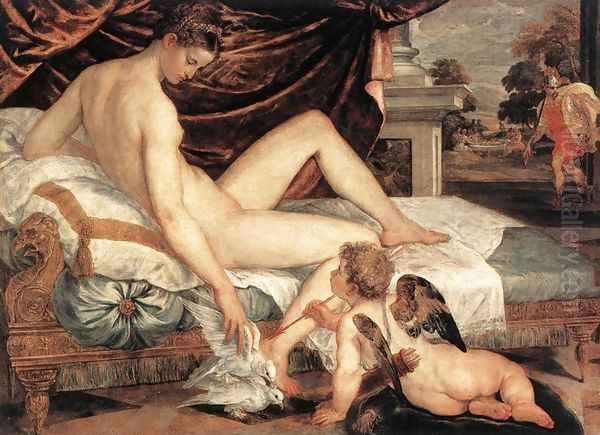
His name itself appears in various forms in historical documents and art historical literature, including Lamberto Suave, Alberto de Olanda (as Giorgio Vasari, the famed art historian, called him, possibly confusing him or using a common Italian moniker for artists from Holland), and Lambert Zustris or Sustris. This variety reflects the linguistic fluidity of the era and the challenges of standardizing names across different cultures.
Information regarding his initial artistic training in the Netherlands is largely speculative. However, it is reasonable to assume he received a foundational education grounded in the prevailing Netherlandish traditions, which emphasized meticulous observation, detailed rendering, and often a strong current of realism. Artists such as Jan van Scorel and Maarten van Heemskerck, who were pioneers in bringing Italian Renaissance influences back to the North, were active during this period, and their work, or that of their circles, might have provided an early artistic environment for Sustris before he embarked on his own transformative journey southward.
The Italian Journey: Rome and the Seeds of Transformation
Like many ambitious Northern European artists of his generation, Lambert Sustris was drawn to Italy, the epicenter of the Renaissance and a land rich with classical antiquities and groundbreaking contemporary art. He is thought to have made his way to Italy sometime in the 1530s, a period when the artistic innovations of the High Renaissance were being absorbed and reinterpreted by a new generation of artists.
His Italian sojourn likely included a significant period in Rome. The Eternal City would have offered Sustris an unparalleled opportunity to study firsthand the masterpieces of antiquity and the monumental achievements of High Renaissance giants such as Raphael and Michelangelo. The powerful forms, dynamic compositions, and idealized beauty of their work left an indelible mark on countless artists. Furthermore, Rome in the 1530s was a key center for the development of Mannerism, an artistic style characterized by elegance, artificiality, and sophisticated compositions.
In Rome, Sustris would have encountered the works of prominent Mannerist painters like Polidoro da Caravaggio and Perin del Vaga, whose elongated figures, complex spatial arrangements, and often emotionally charged narratives were highly influential. This exposure to both classical ideals and contemporary Mannerist trends was crucial in shaping Sustris's artistic development, providing him with a broader visual vocabulary that he would later integrate with his Northern heritage and Venetian experiences.
Venice: In the Shadow and Light of Titian
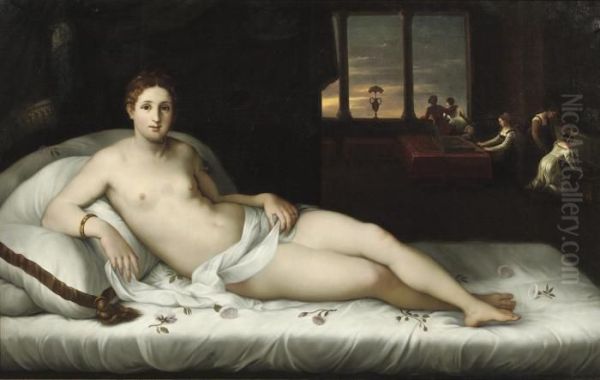
The most decisive phase of Lambert Sustris's career began with his move to Venice, likely in the late 1530s or early 1540s. This maritime republic was a dominant political and commercial power, and its artistic environment was equally vibrant, characterized by a unique emphasis on color (colorito), light, and atmosphere. It was in Venice that Sustris came into contact with Tiziano Vecellio, better known as Titian, one of the most influential painters in the history of Western art.
Sustris is documented as having worked in Titian's highly productive workshop. The exact nature of his role—whether primarily as a pupil, an assistant, or a more independent collaborator—is not always clear, but the association was undoubtedly formative. Being part of Titian's studio provided Sustris with invaluable training in Venetian painting techniques, including the masterful use of oil glazes to achieve rich, luminous colors and subtle tonal gradations, as well as the dynamic application of paint that characterized Titian's mature style.
Titian's influence on Sustris is evident in various aspects of his work, from his approach to figure painting and composition to his adoption of Venetian subject matter, particularly mythological scenes and sensuous depictions of the female nude. However, Sustris was not a mere imitator. He skillfully blended Titian's lessons with his own artistic inclinations, gradually forging a more personal style. During this period in Venice, he would also have been aware of other leading artists of the Venetian School, such as Paris Bordone and Bonifazio Veronese, whose works contributed to the rich artistic milieu.
Collaborations and Travels: Augsburg and Imperial Patronage
Lambert Sustris's connection with Titian extended beyond the confines of the Venetian workshop. He is known to have accompanied the great master on at least two significant journeys to Augsburg, Germany, in 1548 and again in 1550-1551. These trips were undertaken at the behest of Emperor Charles V, who was a major patron of Titian, and also involved commissions from the powerful and wealthy Fugger banking family.
These sojourns in Augsburg were important for Sustris, offering him exposure to a different cultural environment, German art, and the sophisticated tastes of imperial and aristocratic patrons north of the Alps. Working alongside Titian on prestigious commissions, such as portraits and allegorical paintings, would have further honed his skills and enhanced his reputation. It is likely that Sustris assisted Titian in the execution of various works during these periods, and some paintings from Titian's workshop dating to these years may bear traces of Sustris's hand, particularly in the landscape backgrounds, an area where he excelled.
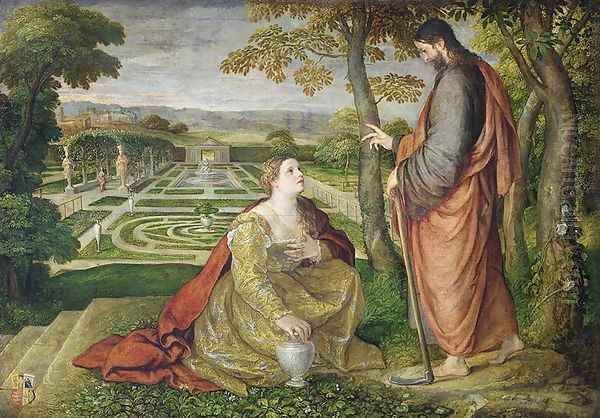
The Augsburg experiences also highlight the international nature of the art world in the sixteenth century, with artists, patrons, and ideas moving across geographical and cultural boundaries. For Sustris, these travels reinforced his position as an artist comfortable in both Italian and Northern European contexts, capable of adapting his style to suit diverse commissions and audiences. This international exposure likely contributed to the hybridity and sophistication that characterize his mature work.
Independent Master: Padua and Continued Venetian Activity
While the association with Titian was undoubtedly a cornerstone of his career, Lambert Sustris also established himself as an independent master. He undertook significant commissions in Padua, a city within the Venetian Republic renowned for its ancient university and rich artistic heritage, having previously hosted masters like Giotto and Donatello. In Padua, Sustris demonstrated his versatility by executing frescoes, a demanding medium that required skill in large-scale composition and rapid execution.
Among his notable Paduan works are frescoes in the Villa dei Vescovi in Luvigliano, a magnificent residence where he contributed to the decorative schemes. He is also credited with works for the Duomo (Cathedral) of Padua. These projects allowed Sustris to showcase his abilities beyond easel painting and to engage with the tradition of monumental wall painting that was so central to Italian Renaissance art.
Even as he undertook independent projects, Sustris likely maintained connections with Venice, the primary center of his artistic activity. He continued to develop his personal style, which increasingly revealed a sophisticated synthesis of the various influences he had absorbed: the meticulous detail of his Northern origins, the rich color and light of Venetian painting, and the elegant, elongated forms characteristic of Mannerism. This fusion resulted in works that were both refined and expressive, appealing to the cultivated tastes of his patrons.
The Art of Lambert Sustris: Style and Characteristics
Lambert Sustris developed a distinctive artistic style marked by several key characteristics that set him apart, even as he operated within the broader currents of sixteenth-century Italian art. His ability to weave together different traditions into a cohesive and elegant visual language is central to his achievement.
A Master of Landscape
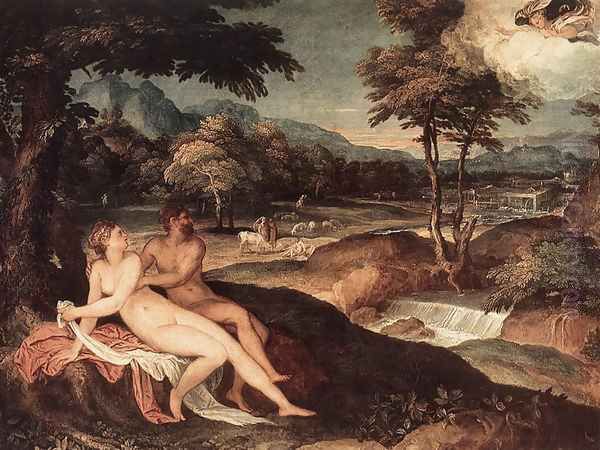
One of Sustris's most significant contributions lies in the realm of landscape painting. Unlike many of his Italian contemporaries for whom landscape often served merely as a backdrop, Sustris frequently gave it a prominent, almost co-starring role in his compositions. His landscapes are not generic settings but are imbued with atmosphere, depth, and a keen observation of natural detail. This emphasis likely stemmed from his Northern European artistic heritage, which had a strong tradition of landscape painting, exemplified by artists like Joachim Patinir and Herri met de Bles.
Sustris skillfully combined this Northern penchant for detail and panoramic views with the pastoral, idyllic qualities often found in Venetian landscapes, which had been pioneered by artists such as Giorgione and the young Titian. His landscapes are characterized by lush foliage, distant blue mountains, carefully rendered trees, and often a sense of tranquil beauty or poetic melancholy. These settings provide not just a location for his figures but also contribute significantly to the mood and narrative of the painting.
Elegant Figuration
Sustris's figures are typically elegant, graceful, and often elongated, reflecting the influence of Mannerism. This stylistic tendency, which emphasized artifice, sophistication, and a departure from the strict naturalism of the High Renaissance, was widespread in Italy during the mid-sixteenth century. Artists like Parmigianino, known for his exquisitely refined and elongated figures, and Francesco Salviati, with his complex and dynamic compositions, were key proponents of this style, and their influence can be discerned in Sustris's work.
His figures often possess a smooth, polished quality in the rendering of flesh tones, and their poses can be sinuous and artfully contrived, embodying the Mannerist ideal of the figura serpentinata (serpentine figure). Whether depicting mythological deities, biblical characters, or allegorical personages, Sustris imbued them with a courtly refinement and an air of sophisticated detachment. This elegance is a hallmark of his paintings, distinguishing them from the more robust or dramatic styles of some of his Venetian contemporaries like Jacopo Tintoretto.
Color and Light
Having spent a considerable part of his career in Venice and in close association with Titian, Sustris naturally absorbed the Venetian emphasis on colorito – the use of color and light to create form, atmosphere, and emotional impact. His palette is often rich and harmonious, though sometimes with cooler tonalities or a more enamel-like finish compared to the warmer, more overtly sensuous colors of Titian or Paolo Veronese.
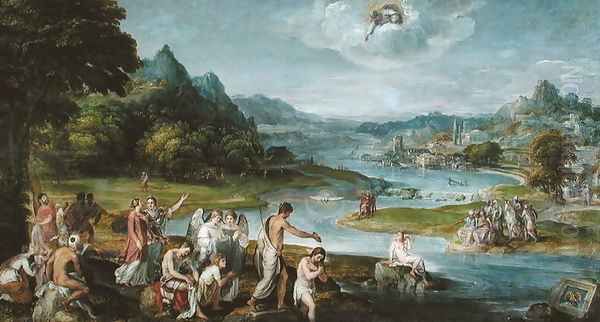
Sustris demonstrated considerable skill in the use of light and shadow (chiaroscuro) to model his figures, define spatial relationships, and enhance the mood of his scenes. Light in his paintings can range from the soft, diffused glow of a pastoral landscape to more dramatic effects in narrative compositions. His handling of light on fabrics, flesh, and foliage contributes to the overall visual appeal and sophistication of his work.
Compositional Approaches
Lambert Sustris's compositions are often carefully constructed, balancing figures and landscape elements to create harmonious and engaging scenes. He frequently tackled complex narrative subjects, both mythological and religious, arranging multiple figures in dynamic or gracefully posed interactions. His skill in integrating these figures seamlessly within expansive and detailed landscapes is particularly noteworthy.
His mythological paintings, often featuring subjects like Venus, Diana, or Jupiter, allowed him to explore the nude female form in idyllic natural settings, a popular genre in Venetian art. In his religious works, he brought a similar elegance and compositional sophistication to biblical narratives. While his compositions can be intricate, they generally maintain a sense of clarity and balance, reflecting his thorough assimilation of Italian Renaissance principles of design, filtered through a Mannerist sensibility.
Key Works: A Closer Look
Lambert Sustris's oeuvre, though subject to some art historical debate regarding attributions, includes a number of significant paintings that exemplify his style and thematic concerns. These works are now housed in major museums across the world.
Venus and Cupid (Musée du Louvre, Paris)
This painting is one of Sustris's most famous works and a quintessential example of his approach to mythological subjects. It depicts the goddess Venus reclining gracefully in a lush, detailed landscape, accompanied by Cupid. The figure of Venus, with her elongated proportions and smooth, pale skin, clearly shows Mannerist influences, reminiscent of artists like Parmigianino. The landscape itself is a significant element, rich in foliage and atmospheric depth, showcasing Sustris's skill in this area. The work invites comparison with Titian's numerous depictions of Venus, yet Sustris brings his own distinct sensibility, characterized by a cooler palette and a more stylized elegance.
Reclining Venus (Rijksmuseum, Amsterdam)
Another exploration of the popular theme of the reclining goddess, this painting in the Rijksmuseum further underscores Sustris's mastery of integrating the female nude with an evocative landscape. The composition, while recalling Venetian prototypes, is infused with Sustris's characteristic refinement. The careful rendering of the natural environment, with its distant views and meticulously depicted flora, highlights his Northern European attention to detail combined with an Italianate sense of pastoral beauty.
Noli me Tangere (Palais des Beaux-Arts de Lille)
This work treats a poignant religious subject: Christ appearing to Mary Magdalene after the Resurrection. Sustris handles the theme with his typical elegance and sensitivity. The figures of Christ and Mary Magdalene are gracefully posed, their interaction conveying a sense of spiritual intimacy. Once again, the landscape plays a crucial role, creating a serene and contemplative setting for the sacred encounter. The painting demonstrates Sustris's ability to apply his stylistic approach effectively to both mythological and religious narratives.
Jupiter and Io (Hermitage Museum, St. Petersburg)
This painting depicts a dramatic moment from Ovid's Metamorphoses, where Jupiter, concealed in a cloud, embraces the nymph Io. Sustris captures the sensuality and mystery of the scene, with Io's luminous form contrasting with the dark, swirling cloud that envelops Jupiter. The composition is dynamic, and the atmospheric effects are skillfully rendered, showcasing Sustris's ability to convey narrative tension and mythological drama. This work is often cited as an example of his mature style, where Venetian color and Mannerist forms are fully integrated.
The Baptism of Christ (Musée des Beaux-Arts de Caen)
In this religious composition, Sustris presents the baptism of Christ by Saint John the Baptist in a broad river landscape. The figures are centrally placed but are harmoniously integrated into the expansive natural setting. The painting reflects both Italian compositional traditions for this theme and Sustris's personal emphasis on landscape. The serene atmosphere and the careful balance of figures and nature are characteristic of his approach to sacred subjects.
Other notable works often attributed to Sustris include various Landscapes with Mythological or Biblical Scenes, such as Landscape with the Good Samaritan, where the narrative elements are almost secondary to the depiction of the natural world. Themes like Diana and Actaeon or Diana and Callisto also provided him with opportunities to combine elegant nudes with his signature landscapes. The range of his subject matter, while predominantly focused on these popular Renaissance themes, consistently showcases his unique stylistic blend.
Artistic Milieu: Influences, Contemporaries, and Connections
Lambert Sustris's artistic development was shaped by a rich and diverse milieu, reflecting his Northern origins and his extensive career in Italy. His work is a testament to the vibrant artistic exchanges of the sixteenth century.
The most significant influence on Sustris was undoubtedly Titian. Working in Titian's studio provided him with unparalleled access to the techniques and artistic vision of one of the era's greatest masters. From Titian, Sustris absorbed the Venetian emphasis on color, light, and expressive brushwork, as well as a repertoire of mythological and portrait subjects.
Within the broader Venetian School, Sustris would have been aware of the legacy of Giorgione, whose poetic, atmospheric landscapes and enigmatic figures had a profound impact on Venetian painting. He was also a contemporary of other important Venetian artists. While Jacopo Tintoretto and Paolo Veronese were slightly younger, their careers were ascending during Sustris's mature period in Venice, and their dynamic compositions and rich colorism formed part of the artistic environment. Other figures like Palma Vecchio, Bonifazio Veronese, and Andrea Schiavone (another artist of non-Italian origin active in Venice, known for his Mannerist tendencies and distinctive brushwork) also contributed to the city's artistic vibrancy. Schiavone, in particular, shares some stylistic affinities with Sustris in his elongated figures and painterly approach.
Sustris's time in Rome exposed him to the monumental art of the High Renaissance, particularly the works of Raphael and Michelangelo, whose mastery of form and composition set a standard for generations of artists. More directly relevant to Sustris's style was the influence of Roman and Central Italian Mannerism. Artists such as Giulio Romano (Raphael's pupil, known for his work in Mantua), the highly influential Parmigianino from Parma, and Francesco Salviati, active in Rome, Florence, and Venice, all contributed to the development of the elegant, sophisticated, and often artificial style of Mannerism. The elongated proportions, graceful contrapposto, and complex compositions seen in Sustris's work owe much to these Mannerist precursors. Early exposure to figures like Polidoro da Caravaggio and Perin del Vaga in Rome would also have been formative.
His Northern Roots remained an important, if sometimes subtle, component of his art. The tradition of detailed naturalism and the prominence of landscape painting in Netherlandish art, as seen in the works of pioneers like Jan van Scorel and Maarten van Heemskerck (both of whom also travelled to Italy), likely informed his approach. While direct connections are speculative, the underlying Northern sensibility for meticulous observation can be felt in his detailed rendering of landscapes and textures. He may also have been aware of developments in Antwerp Mannerism.
His travels to Augsburg brought him into contact with German patrons like the Fugger family and the Imperial court of Charles V, exposing him to different tastes and artistic traditions. Furthermore, Sustris's artistic legacy was continued by his son, Friedrich Sustris (c. 1540–1599). Friedrich became a significant artist in his own right, working primarily in Germany, particularly for the Bavarian court in Munich. He played a key role in disseminating Italian Renaissance and Mannerist styles in Northern Europe, creating a bridge that his father had helped to establish. Other artists whose work might resonate with aspects of Sustris's output include Dosso Dossi, known for his imaginative mythological scenes and landscapes in Ferrara, and Lorenzo Lotto, a Venetian painter with a highly individualistic style.
Later Career and Unanswered Questions
Details about Lambert Sustris's later career, following his documented activities in the mid-sixteenth century, become somewhat scarcer. After his trips to Augsburg with Titian and his work in Padua, he likely continued to be active as a painter, though the precise locations and nature of his commissions are not always clear. Some art historians suggest he may have spent more time in Germany, possibly leveraging the connections made during his Augsburg visits, while others believe he remained primarily based in Venice or the Veneto region.
The date and place of his death are also uncertain. Various dates have been proposed, ranging from the 1560s to as late as c. 1584 or even into the 1590s. Similarly, whether he died in Venice, elsewhere in Italy, or perhaps in Germany remains a subject of scholarly discussion. This lack of definitive biographical information for his later years contributes to the somewhat enigmatic quality that surrounds his figure.
One of the ongoing challenges for art historians studying Sustris is the issue of attribution. Because he worked in Titian's studio and his style shares characteristics with other Venetian and Mannerist painters (such as Andrea Schiavone or Bonifazio Veronese), definitively assigning certain works to his hand can be complex. Over the years, paintings have been attributed, de-attributed, and re-attributed as scholarship has evolved and new evidence or interpretations have emerged.
The confusion over his name in early sources, such as Giorgio Vasari's brief mention of an "Alberto de Olanda" in his Lives of the Most Excellent Painters, Sculptors, and Architects, further complicates the historical record. While Vasari's account is one of the few near-contemporary references, its brevity and potential inaccuracies highlight the difficulties in reconstructing the careers of artists who were not at the absolute forefront of fame in their own time.
Anecdotes and Human Touches
Specific, colorful anecdotes about Lambert Sustris's personal life, of the kind that Vasari often recorded for more prominent Italian artists, are unfortunately rare. His story is pieced together more from stylistic analysis of his works, occasional documentary references, and the broader context of the artistic environments in which he moved.
However, the very variations in his name—Lambert Sustris, Lamberto d'Amsterdam, Lamberto Suave, Alberto de Olanda—can be seen as a kind of "anecdote" in themselves. They reflect his international career, the fluidity of identity for artists who crossed cultural and linguistic borders, and the ways in which individuals were identified by their place of origin in an era before standardized surnames were universal.
The success of his son, Friedrich Sustris, as a prominent court artist in Bavaria, is a significant human touch. It speaks to a familial artistic lineage and the transmission of artistic knowledge and Italianate styles northward, a process in which Lambert himself played a crucial role. Friedrich's career, which included painting, architectural design, and overseeing large decorative projects, demonstrates the lasting impact of the Italian Renaissance on Northern European art, an impact facilitated by artists like his father.
Furthermore, the fact that a Northerner like Sustris could not only assimilate into the highly competitive Venetian art world but also become a valued collaborator of Titian and an independent master in his own right is noteworthy. It underscores his talent, adaptability, and the cosmopolitan nature of the Renaissance art scene, where skill and innovation could transcend geographical origins. His journey from Amsterdam to the heart of the Italian Renaissance is a compelling narrative of artistic ambition and cultural exchange.
Historical Evaluation and Lasting Influence
Lambert Sustris holds a significant, if sometimes underappreciated, place in the history of sixteenth-century European art. His primary importance lies in his role as a key figure among the "Italianate" Northern painters—artists from Northern Europe who traveled to Italy, absorbed Italian Renaissance and Mannerist styles, and often created a sophisticated synthesis of Northern and Southern artistic traditions.
His most notable contribution is arguably in the field of landscape painting. Sustris was one of the Northern artists active in Italy who helped to elevate landscape from a mere background element to a more prominent and expressive component of pictorial composition. He skillfully blended the Northern European tradition of detailed, panoramic landscapes with the atmospheric, pastoral qualities of Venetian landscape painting, creating settings that were both naturalistic and poetic. This approach influenced the development of landscape painting in both Italy and, upon its transmission back, in Northern Europe.
Sustris's artistic style is characterized by a successful fusion of Venetian colorism, Mannerist elegance in figure depiction, and a Northern European sensitivity to detail and naturalism. This hybridity makes his work distinctive and appealing. He demonstrated that an artist of Netherlandish origin could fully master the idioms of Italian art while retaining subtle elements of his own heritage.
While he may not have achieved the towering fame of his mentor Titian, or contemporaries like Tintoretto and Veronese, Sustris's influence was felt. His work would have been seen by patrons and other artists in Venice, Padua, and Augsburg. More directly, his artistic legacy was carried forward by his son, Friedrich Sustris, who became an important conduit for Italianate styles in Germany, influencing the development of late Renaissance and early Baroque art in Bavaria. Through figures like Friedrich, the stylistic innovations that Lambert had absorbed and adapted in Italy found a wider dissemination in Northern Europe.
Modern art historical scholarship continues to refine our understanding of Lambert Sustris's oeuvre and his precise role in the artistic networks of his time. The ongoing process of attribution and the study of his workshop practices contribute to a fuller appreciation of his talents. His paintings are now found in major museums around the world, including the Louvre, the Rijksmuseum, the Hermitage, and the Kunsthistorisches Museum in Vienna, attesting to his recognized skill and historical importance.
Conclusion
Lambert Sustris was an artist who navigated the rich and complex currents of sixteenth-century European art with remarkable skill and adaptability. Born in the Netherlands, he embraced the transformative power of the Italian Renaissance, particularly in Venice, where he absorbed the lessons of Titian and the Venetian school's mastery of color and light. He further refined his style through an engagement with the elegance and sophistication of Mannerism.
His unique artistic achievement lies in the harmonious synthesis of these diverse influences. Sustris created a body of work characterized by graceful figures, often set within lush, atmospheric landscapes that reveal his Northern European heritage and his significant contribution to that genre. Whether depicting mythological idylls, poignant religious scenes, or elegant portraits, his paintings consistently display a refined sensibility and a masterful command of his craft.
Though perhaps not always accorded the same level of recognition as the very top tier of Renaissance masters, Lambert Sustris remains an important figure for understanding the internationalism of sixteenth-century art and the fruitful dialogue between Northern and Southern European artistic traditions. His journey from Amsterdam to the heart of the Venetian art world, and his subsequent career as a respected painter and collaborator, highlight a path taken by many Northern artists who sought inspiration and advancement in Italy. His paintings continue to be admired for their elegance, their beautiful landscapes, and their sophisticated blend of styles, securing him an enduring, if nuanced, place in the annals of art history.